Salmon is a fish found in cold waters that’s known as one of the single healthiest foods you can eat, thanks to its high protein content, antioxidant powers, and of course, its omega-3 fatty acids.
Diets high in salmon are profoundly healthy, according to wide ranging epidemiological studies, and it doesn’t take a whole lot of salmon in your diet to reap the benefits.
Our research team has looked into the best sources of salmon on the market and ranked the best ten. We’ve also dug into the scientific literature to uncover exactly why salmon is so healthy for you.
Research
Rankings
1. Kirkland Signature Wild Alaskan Pink Salmon
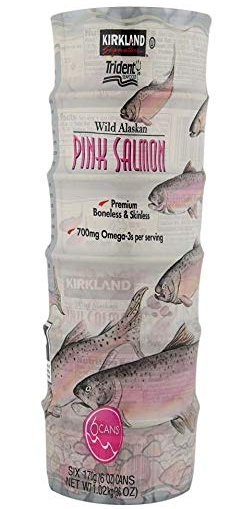
Each of these cans have six ounces of pink salmon, making them good for larger meals or people cooking for two.
They’re less well-suited for smaller meals, unless you’re on a high protein diet. It’s wild-caught, so the nutritional quality is fantastic. All of these perks, and the larger can size, make Kirkland Signature Wild Alaskan Salmon our top pick.
2. Wild Planet Wild Pink Salmon
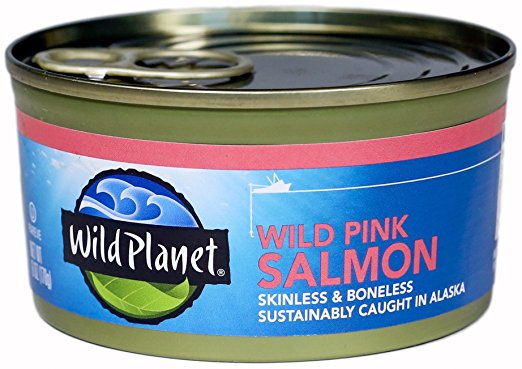
Wild Planet Wild Pink Salmon contains six ounces per can of Alaskan salmon that’s caught wild using sustainable fishing practices.
It’s both nutritious and environmentally healthy, and moreover, this salmon is low in sodium, making it a great pick.
3. Chicken of the Sea Pink Salmon
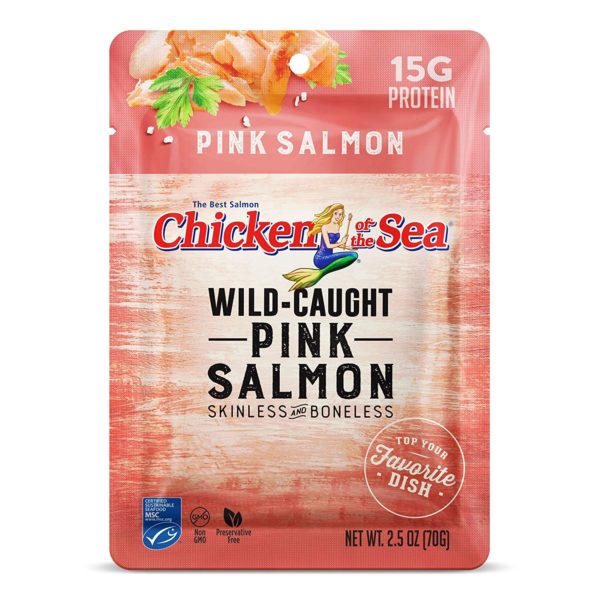
Chicken of the Sea Pink Salmon is vacuum-packed in individual foil packs that contain 2.5 ounces of salmon each.
They’re great for adding a single serving of salmon to salads, and it’s even popular among hikers and backpackers who value a lightweight way to carry around high-quality protein that isn’t going to spoil.
4. Bumble Bee Premium Wild Pink Salmon
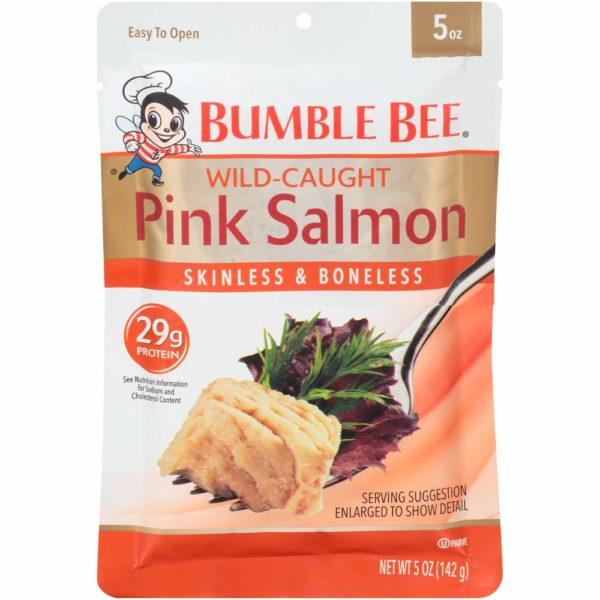
Bumble Bee Premium Wild Pink Salmon makes five ounce vacuum sealed foil packages of salmon that’s wild-caught and excellent for quickly making high-protein meals.
Though not everyone needs five ounces of salmon per serving, those who do should definitely consider Bumble Bee salmon.
5. Epic Snack Strips Salmon Fillet

Epic Snack Strips makes an excellent solution for adding salmon to your diet if you’ve got a busy schedule.
These smoked and dried salmon fillets are 0.8 ounces each, but remember that’s equivalent to a much larger serving of fresh salmon because the water has been removed in the drying process.
Because of some of the compounds produced in the curing process might be unhealthy, not everyone is a fan of preserved meat, but if that’s not a concern for you, this is a great choice.
6. StarKist Alaskan Pink Salmon
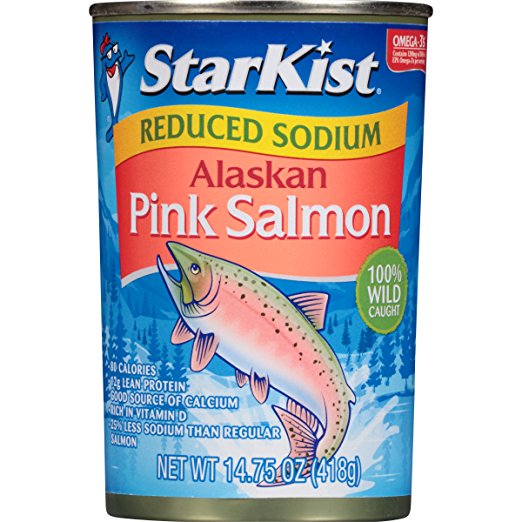
StarKist Alaskan Pink Salmon comes in a large 15 ounce tin that makes it well-suited for making big meals or doing meal prep. This salmon is wild caught, which helps ensure an optimal amount of omega three fatty acids relative to omega six fatty acids.
It’s less well-suited if you don’t eat salmon every day, because once you open it, it will only last for a few days in the refrigerator.
7. Trident Wild Alaskan Smoked Sockeye Salmon

Trident Wild Alaskan Smoked Sockeye Salmon is great for hosting dinner guests, throwing parties, and holidays. This 20 ounce whole half-salmon is smoked with salt and brown sugar to create a rich, savory, and salty flavor.
Even if you really love the flavor of dried salmon, it’s not as well-suited for regular consumption, the high sodium content is a drawback. That being said, it’s still good for special occasions.
8. SeaBear Wild Sockeye Salmon
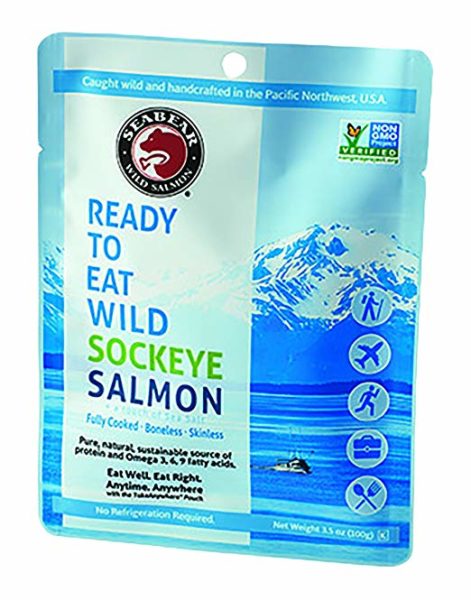
SeaBear Wild Sockeye Salmon makes a vacuum sealed foil pack salmon that uses natural sea salt as the only preservative. Each foil packet contains 3.5 ounces, which is somewhat of an awkward size.
It’s a little big for a normal single serving, but not quite enough for people looking for a large protein-centered meal.
9. Starkist Salmon Creations Lemon Dill
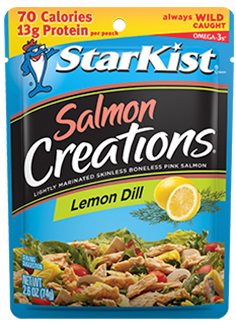
Starkist Salmon Creations Lemon Dill makes adding flavor to a salmon-based meal super easy. These pre-cooked salmon foil packs include lemon, olive oil, and dill that make a big difference if your usual salmon and spinach salad is getting bland.
The primary downside is that adding these flavoring agents demands other ingredients as binders and stabilizers, so if you want pure and simple salmon, this is not the product for you.
10. Alaska Smokehouse Smoked Salmon Jerky

Alaska Smokehouse Smoked Salmon Jerky uses the same drying and smoking process used to create beef jerky, and the result is similar: dried strips that are great for a high-protein snack.
The sodium content is high, though, and salmon cuts are not as consistent as beef cuts, so some of the jerky pieces are quite small.
Category winners
Best salmon overall: Kirkland Signature Wild Alaskan Pink Salmon
Kirkland Signature provides canned, wild-caught Alaskan salmon that’s an excellent all-around pick. Higher in protein and lower in calories than farm-raised salmon, you get a full meal’s worth of salmon in each of the six-ounce cans.
Best canned salmon: Kirkland Signature Wild Alaskan Pink Salmon
Canned salmon can last upwards of five years, so if you’re stocking up, Kirkland Signature is the way to go. It’s wild-caught instead of farm-raised, and unlike some other competitors, it doesn’t skimp on the salmon content in each can. For salmon with a long shelf life, it’s our favorite.
Best foil wrapped salmon: Chicken of the Sea Pink Salmon
Canned salmon is fine when it stays in the pantry, but if you’re backpacking, hiking, or making a meal on the go, foil packed salmon is much lighter and just as healthy. Chicken of the Sea is our favorite in this category thanks to its lightweight packaging and long shelf life.
Best smoked salmon: Trident Wild Alaskan Smoked Sockeye Salmon
For fancy dinners and hors d’oeuvres, Trident is our recommendation. You get a whole half-salmon fillet, weighing in at 20 ounces. Moreover, it’s free from the typical preservatives you see in lower-quality smoked salmon products—the ingredients other than salmon are brown sugar and salt.
Best salmon jerky: Epic Snack Strips Salmon Fillet
Epic Snacks makes a fantastic-tasting salmon jerky that’s perfectly suited for snacking on the go. It’s wild-caught, free of preservatives, and flavored with real onion, garlic, and dill.
Best wild caught salmon: Kirkland Signature Wild Alaskan Pink Salmon
Wild-caught salmon is leaner and lower in calories than farm-raised salmon, and among the wild-caught salmon on the market, Kirkland Signature is the best. These hefty six-ounce cans provide plenty of lean protein and omega-3 fatty acids for healthier eating.
Who should buy salmon?
Salmon is great for individuals of all ages and are beneficial to people who are looking to improve their bone health and reduce overall systemic inflammation. Furthermore, salmon is a very healthy food that can help overweight individuals achieve weight loss goals, when combined with a proper diet and exercise program.
Cooked salmon is safe for all individuals, but raw salmon should not be consumed by pregnant women, the elderly and children.
How we ranked
Wild-caught salmon, like Trident and Seabear, was our preferred choice because of the superior health benefits it provides. Wild salmon contains less saturated fat and calories, but provides more protein, making it ideal for dieting. Farmed salmon also has higher levels of omega-6 fatty acids, which is not ideal, especially in the western world, where our diet runs rampant with omega-6 fatty acids.
Farmed salmon tend to contain traces of antibiotics, which could cause antibiotic resistance down the line. Farmed salmon can also cause a lot of pollution that can enter the local ecosystem and pollute the area. Fresh salmon didn’t make our list because it is often 1-2 weeks old in grocery stores, and can come with other issues like parasites and viruses. If salmon is flash frozen and vacuum-sealed, like Chicken of the Sea, it will be fresh for 6 months, while providing superior health benefits too aging “extra” salmon you might find in the grocery store. Furthermore, flash-frozen salmon kills all parasites and bacteria, preventing the spread of infection.
Salmon comes in a variety of forms, and some are better than others. Salmon jerky, like Alaska Smokehouse, was a great option but ranked a little lower because it often contained a lot of excess salt. Canned salmon was proffered because it provided the best freshness and quality control while saving money. We did not bother with the organic certification because there is currently no USDA certification method for organic fish.
Salmon benefits and side effects
Wild and farmed salmon are excellent sources of important nutrients like omega-3 fatty acids; differences between the two result from the environment they’re raised in and the food they eat.
The health benefits of eating salmon have made headlines in the last while, and people are listening. Consumer demand has grown, resulting in the amount of farmed salmon raised in the last two decades jumping from 27,000 metric tons to more than a million. (1) However, global wild salmon stocks have been depleted by half in the last few decades. (2)
Benefits
There are some nutritional differences between wild caught and farm raised salmon. With more pollutants in oceans, rivers and lakes than ever before, it’s reasonable to question which is safer and more nutritious to consume: wild salmon or farmed salmon.
Farmed salmon are fed processed food high in fat to produce bigger fish in the shortest possible amount of time. Wild salmon eat whatever they find in their environment, and are smaller when harvested than farmed salmon. (3)
Farmed salmon is higher in fat, and this accounts for most of the added calories. It also contains slightly more omega-3 fats and much more omega-6 fats. That means the omega three to omega six ratio is not as favorable in farmed salmon compared to wild salmon.
The diet farmed fish are fed is high in omega-6 fats, which contributes to fast weight gain, readying the fish for market much more quickly.
Wild salmon meat doesn’t contain any vitamin C; this is present in the farmed variety because it is added to their diet.
The “good” fats found in salmon, both wild and farmed, are among the main reasons salmon is recommended as part of a healthy diet; it’s important to understand how the fats stack up in this comparison.
Both omega-3 and omega-6 fatty acids are necessary for optimal health. These essential fatty acids are an integral part of the human diet since it’s not possible for our bodies to make them.
The tricky part is, humans evolved eating about equal parts of omega-3 fatty acids to omega-6 fatty acids, while a typical modern diet clocks in at about 1 part omega-3 to 15 or 16 parts omega-6 fatty acids. (4) The imbalance can be problematic.
Most people already eat too much of foods rich in omega-6, such as what’s found in highly processed vegetable oils.
Consuming more omega 3 fatty acids relative to your omega 6 fatty acid intake is better for your health.
Research suggests consuming excess omega-6 fatty acids can contribute to inflammation, which is implicated in the development of a range of chronic diseases, including diabetes, arthritis, heart disease, asthma, peptic ulcers, Crohn’s disease and sinusitis. (5, 6, 7, 8)
Despite the higher ratio between the two omega fatty acids in farmed salmon, many authorities take the position that it can still make a positive contribution to many people’s diets.
Even though it doesn’t match the better score of 10 parts omega-3 to 1 part omega-6 for wild salmon, the ratio is still good at 3 or 4 parts omega-3 to 1 part omega 6. (9)
Here’s a good example of the impact adding salmon to the diet can have on health: in one small 4-week study, 19 volunteers ate farmed salmon twice weekly; these eight servings of salmon raised blood levels of an omega-3 fatty acid called DHA by 50%. (10)
Health benefits aren’t the only factors to consider when looking at wild vs farmed salmon. Wild salmon is much more expensive than farmed salmon, and in some areas, farmed salmon may be the only type available.
Some believe the health benefits of salmon, including the farmed variety, justify the risk of consuming contaminants like mercury or PCBs, but this is obviously a question of personal standards.
If you’re wondering how the two types of fish stack up in regard to taste and texture, you’re not the only one with that concern.
The Washington Post assembled a tasting panel composed of distinguished chefs and other culinary connoisseurs to explore the issue. The results may surprise you: farmed salmon beat out wild salmon in nearly every session. (11)
And this was simply prepared fish, steamed and served with a little salt.
Side effects
The primary risks associated with salmon are the potential contaminants that you can consume as a result of eating salmon meat. All fish can absorb contaminants from the water they swim in as well as the food they eat, and farmed fish contain much higher levels of several dangerous substances. (12)
Farmed fish from Chile appear to have the lowest level of contaminants, and American aquacultures rate better than European. (13)
Polychlorinated biphenyls (PCBs), chlorinated pesticides and dioxins are among the most common contaminants found in farmed fish; of these, PCBs may be the most dangerous.
When researchers analyzed samples of more than 700 farmed salmon gathered worldwide, the results showed PCB levels in farmed fish averaged about eight times the levels found in wild fish. (14)
PCBs have been linked to an increased risk of cancer (15, 16, 17, 18), and while the FDA considers this level of contamination safe, the Environmental Protection Agency does not.
However, farmed salmon may not have any more mercury on average than wild salmon. Two studies showed little difference, and one study showed wild salmon contained three times the amount of mercury as farmed salmon. (19, 20, 21)
Higher levels of arsenic have been detected in farmed salmon, but the amounts of cadmium, copper and cobalt are higher in wild salmon. (22)
The amounts of trace metals found in both types of fish were low enough that there’s likely no cause for concern.
When it comes to PCB levels, analysts speculate that if EPA recommendations were observed, limiting farmed salmon consumption to once a month would be the accepted guideline. Some experts believe it’s safer for children and pregnant women to eat only wild salmon.
Some may not be willing or able to take the risk of ingesting PCBs; for these folks, wild salmon is the clear winner on that score.
FAQ
Why is salmon so expensive? The price of salmon has increased in recent years due to a declining salmon population on a near-global scale. Additionally, there have been occurrences of diseases, parasites, and even toxic algae that has been affecting the population of salmon. The price of salmon also varies depending on the type of salmon and its native location.
Is eating salmon good for you? Salmon is a highly nutritious food that includes many important nutrients in every serving. Most importantly, salmon offers high levels of Vitamin D and omega-3 fatty acids, which are beneficial for bone development and maintenance of the circulatory system. Omega-3 fatty acids are connected to improved heart health and are widely recommended by medical professionals. Salmon also provides about 25 grams of protein per serving, making salmon somewhat protein-dense. The fish is also moderately rich in iron, potassium, and Vitamin B12. Some studies show that salmon may reduce the incidences of cardiovascular disease, depression, cancer, and even mortality (23).
Is it safe to eat salmon every day? While the Food and Drug Administration does suggest a limit on how much salmon a person should consume weekly, there are no real risks associated with eating salmon on a daily basis; particularly because of the large number of health benefits associated with eating salmon. In fact, many health organizations encourage people to consume salmon or other fatty fish several times per week to reap the most benefits.
Is salmon high in mercury? Most fish options include some amount of mercury, but salmon has significantly lower mercury levels compared to other seafood. Recent studies show that, despite the presence of mercury in salmon and other fish, there is no direct correlation between eating these fish and the development of cardiovascular diseases. With that said, the Food and Drug Administration suggests consumption of less than 12-ounces of fish like salmon as a preventative measure (24).
Is salmon the healthiest fish? It would be accurate to say that salmon has greater health benefits than any other fish available to eat. Not only does salmon have extraordinary levels of Vitamin D, omega-3 fatty acids, and Vitamin B12, it also has high levels of protein and a lower mercury level than other common fish.
Is salmon healthier than chicken? Chicken and salmon are very similar when it comes to their macronutrient and micronutrient makeup. Per serving, salmon has an average of 5 more grams of protein than chicken (25 grams for salmon and 20 grams for chicken). Chicken has a total fat content of about 13 grams per serving, with 5 grams of monounsaturated fat, 3 grams of polyunsaturated fat, and 4 grams of saturated fat. In comparison, salmon has a total fat content of about 10 grams per serving, with 10 grams of monounsaturated fat and 2 grams of polyunsaturated and saturated fats. Salmon also has significantly higher micronutrient values as compared to chicken. Salmon boasts much higher levels of choline, Vitamin B12, selenium, phosphorus, and other micronutrients. Considering the micronutrients and macronutrients in both chicken and salmon, salmon is far more nutritional and provides greater benefits overall.
Do you have to wash salmon before cooking? No, you do not have to rinse or wash salmon before cooking. Despite popular belief, rinsing uncooked meats does not reduce bacteria on the surface. In terms of bacteria, the only way to reduce or completely kill the bacteria in uncooked food is to cook the food thoroughly and at a proper temperature. Additionally, attempting to rinse uncooked salmon may result in the spread of bacteria in the sink and the counter.
Is salmon safe during pregnancy? Because of the high nutritional value of salmon, it is often recommended that pregnant women eat salmon or similar fish during their pregnancy. The recommended limit is about 12 ounces per week, which works out to about three servings of salmon per week. In general, fish is safe to eat while pregnant as long as it is not a fish known for its high levels of mercury. Raw salmon is not recommended, so cooking the salmon thoroughly at the recommended temperature is advised.
How can you tell when salmon is fully cooked? The most definitive way to know if salmon is fully cooked is by its color. Salmon is normally a reddish color when raw and more of a pink color when fully cooked.
Why does the Food and Drug Administration recommend an internal temperature of 145 degrees? The Food and Drug Administration recommends this internal temperature because it decreases the chances of the salmon having bacteria or other food borne pathogens.
What’s the best way to cook salmon? There are several ways to cook salmon, which each provide different benefits. Broiled salmon is the quickest way to cook salmon, taking about three minutes. Roasting salmon allows you to make larger quantities of salmon in a shorter period of time. Fried salmon makes for a crispy outside and takes about 10 minutes. Grilled salmon is argued as the healthiest way to cook salmon and takes about 10 minutes. Poached salmon drastically reduces the fat content but takes a long time, around 25 minutes.
Can you eat salmon raw? While it is possible to eat salmon raw, there are many guidelines you should follow to maintain safety and health. Raw salmon can be associated with bacteria, viruses, and parasites if not stored properly. It is generally recommended to store the fish at a temperature below -31 degrees, but this will not guarantee all bacteria, viruses, or parasites are killed. It is a much better idea to eat cooked salmon to reduce potential health risks that come with raw fish. Additionally, special populations, such as women who are pregnant, those with compromised immune systems, and older adults, should avoid consuming raw salmon to reduce the risk of developing illnesses or viruses as a result of eating raw salmon.
How do you remove the skin from salmon? To remove the skin from salmon, you’ll need a cutting board and a sharp knife. Place the salmon on the cutting board and begin at the tail of the fish. First, separate the skin from the rest of the fish near the tail. Next, slide the knife the length of the fish just underneath the skin level and peel the skin off.
Are there bones in salmon fillets? When processing the salmon, the majority of bones within the fish are removed before being sold. While there may be smaller bones found in salmon fillets, they are generally safe to eat. These small bones are called pin bones, and they are relatively easy to remove when preparing the fish. In general, when purchasing salmon fillets at the supermarket, there will likely be no bones present other than possible pin bones.
The best way to remove pin bones is to use needle-nose pliers (or another type of pliers) to pull them out.
What does salmon look like when it’s cooked? Cooked salmon looks very different than raw salmon. Uncooked raw salmon is typically red and thick, doesn’t break apart as easily and can have a slimy texture. Once cooked, salmon achieves a pink or even brownish tint throughout and is more likely to break apart and flake.
How are wild and farmed salmon different? Wild-caught and farm-raised salmon are different both the way they are sourced but also in nutrition. Farmed salmon is higher in fat since they are fed processed food and contains more omega-3 fats and much more omega-6 fats than wild salmon. Vitamin C is also found in farmed salmon since its added to their diet, but not in the wild. Wild salmon tend to be leaner and smaller than farmed salmon, containing more protein and a better omega 3 to omega 6 ratio.
Are omega 6 fatty acids bad? In moderation, no, omega 6 fatty acids are not bad. However, in today’s society, there is a drastic imbalance of omega 6 fatty acids to omega 3 fatty acids (15:1), which can be problematic. Research suggests consuming excess omega-6 fatty acids can be a major precursor to systemic inflammation, which is believed to play a part in the development of various chronic diseases, such as diabetes, asthma, heart disease, and Crohn’s disease.
What is the ideal score of omega 3 to omega 6’s? For optimal health, the ideal ratio is 10:1 of omega 3 to omega 6 fatty acids. Wild salmon contains a good ratio of 4:1, which is still great.
Is wild salmon expensive? Yes, wild salmon is almost always more expensive than farmed salmon, even if it’s flash-frozen. Unfortunately, many areas only carry farmed salmon.
Is farmed salmon a health hazard? Farmed salmon can contain contaminants like mercury and PCBs, making it a health hazard. That being said, some experts believe that the health benefits of salmon outweigh the cons of consuming a small number of contaminants.
Does farmed salmon taste better than wild salmon? According to various chefs, famed salmon always beat out wild salmon in terms of taste.
Does salmon contain contaminants? Yes, some salmon can absorb contaminants from the water they swim in and the food they eat. Farm salmon is especially vulnerable, containing significantly higher levels than wild salmon, including Polychlorinated biphenyls (PCBs). PCBs are very dangerous and have been linked to an increased risk of cancer. The current levels found in farmed fish are considered safe by the FDA but not safe by the Environmental Protection Agency.
What type of salmon has the lowest level of contaminants? Wild fish will have the lowest level of contaminants with farmed fish containing about eight times the levels of PCBs found in wild fish. Regarding heavy metals, wild salmon can have more mercury, copper, cobalt, and cadmium that farmed salmon, but has lower levels of arsenic. If choosing farmed fish, try and get it from Chile, as farmed salmon from there appear to have the lowest levels of contaminents.
Should pregnant women eat farmed salmon? Due to higher levels of PCBs, it’s recommended that pregnant women only consume cooked salmon that’s caught in the wild. Children should also follow the same protocol.
Does salmon cause side effects? The fish itself should not cause side effects in most individuals unless you are allergic. The main side effects salmon may cause would be in relation to the contaminants salmon may absorb, including antibiotics and pesticides. The chemicals can wreak havoc over time on your gut microbiome, but no long term studies have been done to show the damage. Like any food, salmon can also cause choking.
Related articles
Recap
Salmon is an incredibly healthy food, and numerous epidemiological studies have shown a clear link between higher consumption of fish and better long term health.
For salmon, wild caught fish seem to beat out farmed salmon when it comes to optimal nutrient levels and low levels of contamination.
Contaminant levels are higher in farmed fish, but when cost and availability are factored into the equation, the trade-off for potential health benefits resulting from adding omega-3 fatty acids found in salmon to your diet are still worth it.
For Bodynutrition’s #1 salmon recommendation, click here.